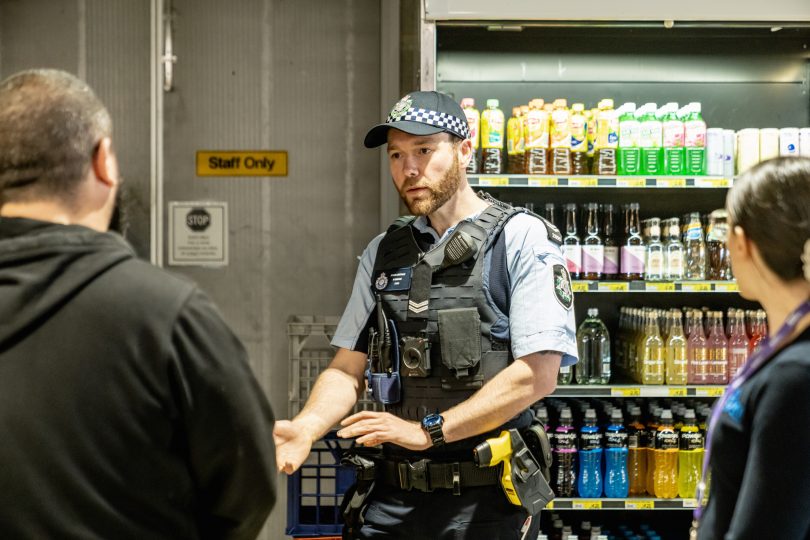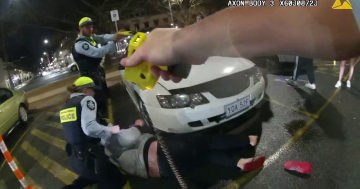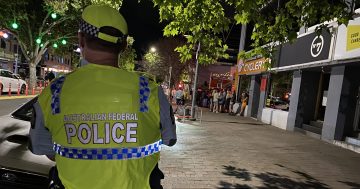
Police have embraced Tasers and body cameras, and crime overall is down, according to the ACT Policing Annual Report. Photo: ACT Policing.
The use of Tasers by ACT police to subdue offenders continues to rise as the number of times firearms were drawn declined in 2019-20.
Overall, the number of use of force reports submitted by ACT Policing increased 11.3 per cent in 2019-20 from 1267 to 1410 when compared to the previous year, according to its Annual Report.
The reported use of Tasers, or Conducted Electrical Weapons, was up 61.4 per cent, from 215 in the previous year to 347 in 2019-20.
The reports attributed the increase to more officers receiving training and being issued with CEWs.
”The use of CEWs offers members an alternative method of conflict resolution and this may reduce the use of other use of force options such as firearm-related reports,” it said.
But in 2017, mentally ill Waramanga man Anthony Caristo, who had a knife and was threatening to kill himself, died after being Tasered in his home. Coroner James Stewart cleared the police sergeant who fired the Taser of any wrongdoing, finding that his actions in the circumstances were reasonable and justified.
Mr Stewart recommended that the Australian Federal Police review its governance and training on Tasers.
The statistics reflect just how much police have come to rely on Tasers and how quickly they have been taken up, with only 45 reports of use just three years ago in 2016-17.
Police resorted less to firearms in 2019-20, down 23.1 per cent from 78 reports to 60, while chemical agents such as capsicum spray were used 117 times, down slightly from 120 in 2018-19.
But the use of batons rose 28 per cent, from 25 to 32, while handcuffs were deployed 854 times, up slightly from 829.
The report also says that the $2.7 million roll-out of body cameras has had a positive impact on police work and interactions with the public.

A Taser or Conducted Electronic Weapon: police use was up 61.4 per cent. Photo: File.
They were also speeding up investigations into complaints made against police.
”The technology has had a noted effect on reducing behavioural escalations when speaking with possible offenders who know they are being recorded,” the report said.
”Body-worn cameras support and provide assurance for the critical decision making of members on the road. AFP Professional Standards has seen a considerable reduction in the time it has taken to assess excessive use of force complaints from the public.”
Alleged conduct breaches fell 22.22 per cent in 2019-20 from 216 to 168, and 33 per cent since 2016–17. Reports of alleged corruption fell 31.25 per cent.
In 2019–20, 137 complaints were finalised, an increase of 10 compared to the previous year, with 43 established, the same number as in 2018-19.
Crime overall was down in 2019-20, possibly due to less social activity generally due to coronavirus restrictions.
There were 17,525 reported offences against property, a decrease of 12.2 per cent (or 2429 offences), while there were 3477 offences against the person, including assaults and sexual offences, down 10.5 per cent or 409 offences.
But reports of family violence continued to rise, which the report says may show more of a willingness to take a matter to the police.
It says 43.8 per cent of all assaults were family violence-related, and this was 1.6 per cent over the 12 months, with long-term trends over 10 years showing an increase of 37.3 per cent.
The report says ACT Policing has maintained a strong focus on improving approaches to family violence, such as a new Family Violence Risk Assessment Tool being developed and regular engagement with stakeholders.
ACT Policing failed to meet its clearance rate target of 72 per cent or more for all offences against the person, falling short at 70.3 per cent.
Due to the complexity of property crime, the clearance rate target is 15 per cent, which police met.
They had mixed results with response times, achieving its 80 per cent target for Priority One (life-threatening or critical) incidents by responding to 85.6 per cent of incidents within 10 minutes.
But for Priority Two incidents, which are supposed to be responded to within 20 minutes, police managed only 74.4 per cent.
The report says police are facing an increasing number of Priority Two call-outs, which have risen 51.5 per cent over the past six years.
”With the increased demand on ACT Policing through calls for service, ACT Policing continues to deal with more resource-intensive matters that require police attendance,” it said.
Police exceeded the 90 per cent target for Priority Three incidents, which require a response no later than 48 hours from initial contact.





















